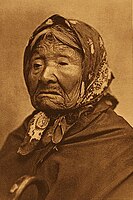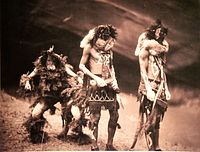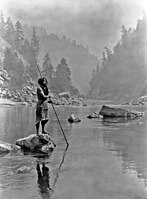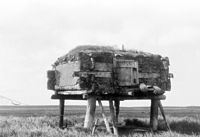Edward S. Curtis
| Edward S. Curtis | |
|---|---|
 | |
| Bizitza | |
| Jaiotzako izen-deiturak | Edward Sheriff Curtis |
| Jaiotza | Whitewater (en) |
| Herrialdea | |
| Heriotza | Whittier (Kalifornia), 1952ko urriaren 19a (84 urte) |
| Hobiratze lekua | Forest Lawn Memorial Park (en) |
| Heriotza modua | berezko heriotza: miokardio infartu akutua |
| Familia | |
| Anai-arrebak | ikusi
|
| Hezkuntza | |
| Hizkuntzak | ingelesa |
| Jarduerak | |
| Jarduerak | argazkilaria, antropologoa, esploratzailea, film-zuzendaria eta gidoilaria |
Parte-hartzailea
| |
| Lantokia(k) | Ameriketako Estatu Batuak eta Seattle |
| Genero artistikoa | erretratua |
Edward Sheriff Curtís (Whitewater, Wisconsin, 1868ko otsailaren 19a - Los Angeles, 1952ko urriaren 19a) estatubatuar argazkilari eta etnologoa izan zen.
Hamazazpi urterekin argazkilaritza ikasten hasi zen Saint Paulen. Bi urte geroago, familiarekin Seattlera joan eta argazki estudio baten erdia erosi zuen. 1895etik amerindiar Ipar anerikarrei argazkiak ateratzen hasi zen. 1898an Argazkilari Elkarte Nazionalaren sari bat irabazi zuen.
Argazkilari ofizial gisa parte hartu zuen Alaskara eta Montanako Blackfootarren lurraldera egindako espedizioetan. John Pierpont Morganek 1906an kontratatu zuen amerindiarren bizitza dokumentatzeko eta argazkiak ateratzeko. 80 tribu ingurutako kideen 40.000 argazki baino gehiago egin zituen. 1912an In the Land of the Head Hunters dokumentala filmatu zuen eta 1920ko hamarkadan Cecil B. DeMilleren kamera-laguntzailea izan zen Hollywooden
Iruditegia[aldatu | aldatu iturburu kodea]
-
Duwamish tribuko Angeline printzesa, 1896ko fotograbatua. Edward Sheriff Curtis
-
Sendagile navajoa. Edward S. Curtis. USA, 1900. The Wellcome Collection, Londres
-
Navajo Yebichai (Yei Bi Chei) dantzariak. Edward S. Curtis. AEBak, 1900. The Wellcome Collection, Londres
-
A smoky day at the Sugar Bowl—Hupa, c. 1923. Hupa man with spear, standing on rock midstream, in background, fog partially obscures trees on mountainsides.
-
White Man Runs Him, c. 1908. Crow scout serving with George Armstrong Custer's 1876 expeditions against the Sioux and Northern Cheyenne that culminated in the Battle of the Little Bighorn.
-
The old-time warrior: Nez Percé, c. 1910. Nez Percé man, wearing loin cloth and moccasins, on horseback.
-
Crow's Heart, Mandan, c. 1908
-
Mandan man overlooking the Missouri River, c. 1908
-
Mandan girls gathering berries, c. 1908
-
Mandan hunter with buffalo skull, c. 1909
-
Zuni Girl with Jar, c. 1903. Head-and-shoulders portrait of a Zuni girl with a pottery jar on her head.
-
Navaho medicine-man, c. 1904 (with 1913 signature)
-
Cheyenne maiden, 1930
-
Hopi mother, 1922
-
Hopi girl, 1922
-
Canyon de Chelly – Navajo. Seven riders on horseback and dog trek against background of canyon cliffs, 1904
-
Apache, Morning bath, c. 1907
-
Mandan lodge, North Dakota, c. 1908
-
Food caches, Hooper Bay, Alaska, c. 1929
-
Navajo Flocks, c. 1904[3]
-
Navajo Sandpainting, c. 1907[4]
-
Ehungile navajoa, c. 1907[5]
-
Mutilak kaiakean, Nunivak, 1930
-
Theodore Roosevelten erretratua (1904), orotone prozesuaz. Edward Sheriff Curtis.
Erreferentziak[aldatu | aldatu iturburu kodea]
- ↑ Description by Curtis: "A well-known Navaho medicine-man. While in the Cañon de Chelly the writer witnessed a very interesting four days' ceremony given by the Wind Doctor. Nesjaja Hatali was also assistant medicine-man in two nine days' ceremonies studied – one in Cañon del Muerto and the other in this portfolio (No. 39) is reproduced from one made and used by this priest-doctor in the Mountain Chant."
- ↑ Description by Curtis: "This portrait of the historical old Apache was made in March, 1905. According to Geronimo's calculation he was at the time seventy-six years of age, thus making the year of his birth 1829. The picture was taken at Carlisle, Pennsylvania, the day before the inauguration of President Roosevelt, Geronimo being one of the warriors who took part in the inaugural parade at Washington."
- ↑ Description by Curtis: "The Navaho might as well be called the 'Keepers of Flocks'. Their sheep are of the greatest importance to their existence, and in the care and management of their flocks they exhibit a thrift not to be found in the average tribe."
- ↑ Description by Curtis: "One of the four elaborate dry-paintings or sand altars employed in the rites of the Mountain Chant, a Navaho medicine ceremony of nine days' duration."
- ↑ Description by Curtis: "The Navaho-land blanket looms are in evidence everywhere. In the winter months they are set up in the hogans, but during the summer they are erected outdoors under an improvised shelter, or, as in this case, beneath a tree. The simplicity of the loom and its product are here clearly shown, pictured in the early morning light under a large cottonwood."





![Navajo medicine man – Nesjaja Hatali, c. 1907[1]](http://upload.wikimedia.org/wikipedia/commons/thumb/4/42/Navajo_medicine_man.jpg/149px-Navajo_medicine_man.jpg)








![Geronimo – Apache (1905)[2]](http://upload.wikimedia.org/wikipedia/commons/thumb/7/74/Edward_S._Curtis_Geronimo_Apache_cp01002v.jpg/137px-Edward_S._Curtis_Geronimo_Apache_cp01002v.jpg)








![Navajo Flocks, c. 1904[3]](http://upload.wikimedia.org/wikipedia/commons/thumb/3/31/Navajo_flocks.jpg/200px-Navajo_flocks.jpg)
![Navajo Sandpainting, c. 1907[4]](http://upload.wikimedia.org/wikipedia/commons/thumb/a/a1/Navajo_sandpainting.jpg/200px-Navajo_sandpainting.jpg)
![Ehungile navajoa, c. 1907[5]](http://upload.wikimedia.org/wikipedia/commons/thumb/f/f6/Navajo_weaver.jpg/200px-Navajo_weaver.jpg)

